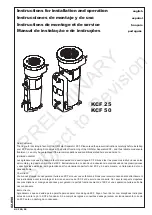
YORK INTERNATIONAL
62
FORM 220.11-NM2 (602)
Insert the locking disk, Fig. 4B (Item 74)
into the
seal recess and set the top half of the entrance
plate in position and start one end in the casing
groove. Carefully rotate the two halves together
approximately 45° clockwise to align the exit plate
splitline horizontal and install the exit plate and seals,
similar to the first stage. As you install each suc-
cessive set of diffusers, be sure to center the clear-
ance and recheck the total rotor axial float from
your zero and record the figure. It is normal to lose
some of your forward travel, do not reset the zero.
If you lose more than .040" on a 26" machine or
.060" on 38" and 55" units, check to find out why.
If the space between the diffusers in
small machines is too close to permit
working, and alternate method of cen-
tering the exit diffuser plates is to
mount an indicator on the rim of an
impeller and read the O.D. of the exit
plate. Adjust the position as before un-
til you show concentric within .003".
4. The exit diffuser for the last stage is a solid disk
and the sump must be removed to install it. Remove
the discharge end shaft bearing, install the guide
pins and dismount the sump. If the compressor has
internal vent tubes, align the diffusers and install
them at this time. Be careful not to damage the seals
at the diffuser. Set the last stage exit plate into the
casing, be careful of the shaft journal and tighten
the four recessed cap screws. Install the piston ring
housing and torque the cap screws. Refer to
Install-
ing Balance Piston Seal Ring. Install the seal ring
with 75% of the clearance at the top of the assem-
bly, 25% at the bottom of the seal.
5. Lift the sump and install the piston ring. Mount the
sump. Refer to Installing the Sump. Fit the shaft
and thrust bearings. Record the total float of the
rotor after all stages have been installed. Bolt up
the oil pump and record the drawback from the full
forward position of the rotor after all stages have
been installed. You should be approximately 50%
back from the suction end. If less than 45% or
greater than 55% adjust by changing the sump gas-
kets. A rotor that is not in center with diffusers may
impact performance.
6. Remove the oil pump. Loosen the bolts holding the
PRV housing and sump. Slide each of them out ap-
proximately 1/4". Tie the gaskets back with thread.
Center the roll pins on top of the diffusers with a
straight edge and level. Make a reference mark on
each diffuser at the casing gasket so you can see if
the diffusers shift as the casing is lowered. Current
production machines have the diffuser roll pins lo-
cated at the casing split line. Be sure they are in the
slots while lowering the housing top half. Be sure
any jackbolts used to raise the top half have been
removed. Paint the casing gasket with a release com-
pound or spray teflon. Screw the four guide studs
in the lower casing, be sure they do not interfere
with the flanges.
Newer production compressors have
the diffuser anti-rotation pins located
at the horizontal joint. Pre-1995 com-
pressors used top dead center for dif-
fuser roll pins.
INSTALLING COMPRESSOR CASING TOP HALF
1. When you rig the top half, pick it up flat and level.
Lift from a center point with the lines from the cas-
ing lugs secured at the hook. Use a come-a-long of
appropriate capacity from the hook for precise level-
ing. As you raise the top half, clean the lower sur-
face. Apply heavy grease or
Never Seize
to the guide
studs. Center the casing over the studs and as you
lower the top half, rock it gently if necessary. Watch
the reference marks and ease off for the last inch.
The top casing should sit firmly if the roll pins are
aligned. If the diffusers shift as you lower the casing,
you may cure the problem by installing jackbolts in
the lower casing extending up evenly about an inch.
Lower the top half down on the jackbolts and ease it
down by gradually turning each bolt one turn at a
time until the top half is seated.
2. Clean the dowel pins and dowel pin holes. Install the
taper pins. Install the casing bolts hand tight. Start-
ing from the center of both sides, alternately torque
two bolts on each side and work toward each end.
The torque values are quite high so incremental steps
may be utilized
(See Compressor drawing). Use a
multiplying or hydraulic torque wrench if possible.
When all casing bolts are tight, install and torque the
remaining PRV and sump cap screws.
Service
Содержание Turbomaster M 255
Страница 9: ...FORM 220 11 NM2 602 9 YORK INTERNATIONAL FIG 2 TYPICAL COMPRESSOR CROSS SECTIONAL VIEW LD07317 1...
Страница 15: ...FORM 220 11 NM2 602 15 YORK INTERNATIONAL FIG 3 TYPICAL PRIMARY COMPRESSOR GAS FLOW LD07318 3...
Страница 16: ...YORK INTERNATIONAL 16 FORM 220 11 NM2 602 FIG 4A MAJOR COMPONENTS LD07319 Operation...
Страница 31: ...FORM 220 11 NM2 602 31 YORK INTERNATIONAL Operation 3 This page intentionally left blank...



































